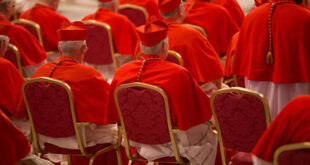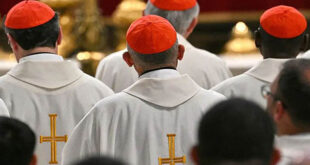1. Introduction: The Meaning and Importance of Immixion in Catholic Theology
Immixion is a term that, although little known outside certain theological circles, has profound relevance in Catholic liturgy. It refers to the act in which a small portion of the Body of Christ, that is, a part of the consecrated host, is mixed with the chalice containing the Blood of Christ during the celebration of the Eucharist. This symbolic, brief but significant gesture represents the inseparable union of the Body and Blood of Jesus in the fullness of the Eucharistic sacrifice.
In a broader sense, immixion offers a rich source of theological and spiritual reflection. In the Catholic faith, this act has deep implications for how we understand the mystery of salvation, the real presence of Christ in the Eucharist, and the unity of the Church as the Body of Christ. By exploring this liturgical gesture, we are invited to delve into the Eucharistic experience and the meaning of the union between Christ and his Church, as well as the unity among the members of the Christian community.
This article aims to explain the theological context of immixion, its history in the Church’s liturgy, and how Catholics can apply this concept to their daily spiritual lives. Immixion is not just a ritual act, but a constant invitation to recognize the centrality of the Eucharist in Christian life as a source of unity, redemption, and transformation.
2. History and Biblical Context: The Origin of Immixion
The origin of immixion as a liturgical act has deep roots in the Church’s Eucharistic tradition. Although we do not find explicit mentions of immixion in Sacred Scripture, the concept underlying this act is based on the unity of the Body and Blood of Christ, which traces back to the account of the Last Supper as described in the Gospels.
At the Last Supper, Jesus took bread and wine, blessed them, and offered them as his Body and Blood to the disciples, saying, “This is my body, which is given for you… This cup is the new covenant in my blood, which is poured out for you” (Luke 22:19-20). In this context, Jesus instituted the sacrament of the Eucharist, in which the bread and wine become his Body and Blood truly, though under the appearances of the sacramental elements.
The practice of immixion, although not directly mentioned in the Gospels, reflects the belief that in every particle of the consecrated bread and every drop of the consecrated wine, Christ is present in his entirety—that is, in his Body, Blood, Soul, and Divinity. This idea of totality is fundamental in Eucharistic theology, and immixion is a symbolic way to express this reality.
Historically, immixion began to form part of the Roman liturgy in the early centuries of Christianity when the Church sought to emphasize the relationship between the two consecrated elements of the Eucharist. In the early Church, the act of mixing a small portion of the consecrated bread with the chalice was seen as a visible expression of the unity and integrity of Christ’s sacrifice.
Over the following centuries, the practice of immixion was consolidated in the liturgy of the Western Church, becoming a regular gesture within the Mass rite. In many Eastern traditions, this practice also holds a prominent place, although with some liturgical variations. In all these traditions, immixion remains a powerful symbol of the fullness of the Eucharist and the redemption Christ offers to humanity.
3. Theological Relevance: Immixion as an Expression of the Mystery of Salvation
From a theological perspective, immixion holds deep significance beyond being a simple ritual act. This liturgical gesture symbolizes the indivisible unity of Christ’s sacrifice, in which his Body and Blood are offered together for the salvation of the world. This unity reminds us that the salvation Christ offers is integral and total: it encompasses not only our spiritual redemption but also our physical restoration and our full communion with God.
Catholic theology holds that in the Eucharist, Christ gives himself to us completely. This means that both in the consecrated bread and wine, Christ is fully present. Immixion, by symbolically uniting the Body and Blood of Christ, reinforces this understanding and invites us to recognize that when we receive Communion, we are participating in the totality of Christ’s mystery: his incarnation, his sacrifice, his resurrection, and his ascension.
Moreover, immixion also has profound significance concerning the Church as the Body of Christ. Just as the Body and Blood of Christ are united in the Eucharist, the members of the Church are called to be united in communion with Christ and with one another. Immixion, therefore, is not only an expression of the unity between the Eucharistic elements but also a call to unity among believers.
This aspect of immixion invites us to reflect on the call to communion in the Christian life. In a world marked by division and conflict, the Eucharist—and the gesture of immixion in particular—is a powerful reminder that we are called to be one in Christ. The unity we celebrate in Mass is not only a spiritual reality but also a mission that we must live in our daily relationships.
4. Practical Applications: Living the Unity of Immixion in Daily Life
Although immixion is a liturgical gesture that occurs in the context of the Mass, its spiritual implications can extend into our daily lives in various ways. Here are some ways in which believers can integrate the meaning of immixion into their spiritual lives and their relationships with others:
a) Fostering unity in the family and community: Just as the Body and Blood of Christ are united in the Eucharist, Christians are called to live in unity with their brothers and sisters in faith. This means actively working toward reconciliation, forgiveness, and peace in our families and communities. Immixion reminds us that true communion with Christ also involves authentic communion with others.
b) Participating in the Eucharist with devotion: Immixion invites us to approach the Eucharist with a renewed sense of reverence and gratitude. When we receive the Body and Blood of Christ in Communion, we participate in a profound mystery of unity and divine love. Every Eucharistic celebration is an opportunity to renew our dedication to God and to others.
c) Cultivating charity and service to those in need: Immixion symbolizes Christ’s total self-giving for our salvation. Similarly, we are called to live lives of charity and service, especially toward those who are most in need. Immixion reminds us that our faith cannot be merely a personal or internal experience but must manifest in concrete acts of love and justice.
d) Promoting unity in the Church: In a context of increasing divisions and tensions within the Church, the symbol of immixion challenges us to be agents of unity and reconciliation. This involves engaging in respectful dialogue, seeking mutual understanding, and working for communion among all members of the Body of Christ, regardless of our differences.
5. Contemporary Reflection: Immixion in the Modern World
In the contemporary world, where divisions, individualism, and isolation are becoming increasingly evident, the symbolism of immixion takes on special relevance. This small liturgical act reminds us that salvation is not something we can achieve on our own but is offered to us in union with Christ and his Body, the Church.
The Eucharist, and particularly the gesture of immixion, invites us to counter modern tendencies toward fragmentation and selfishness and to embrace a life of communion and service. In a world that often values independence more than interdependence, immixion reminds us that our true identity as Christians is found in our belonging to the Body of Christ.
Additionally, in a context of globalization and migration, immixion calls us to recognize the dignity and worth of every person, regardless of their background or condition. Just as the elements of bread and wine are united in the Eucharist to form the Body and Blood of Christ, we, as Christians, are called to work for unity and justice in a divided world.
Conclusion: Living the Mystery of Immixion in Our Christian Lives
Immixion, though a simple and discreet liturgical act, holds profound meaning that can enrich our Christian lives. It reminds us of the indissoluble unity between the Body and Blood of Christ and invites us to participate fully in the mystery of the Eucharist, in which Christ gives himself completely for our salvation.
In our daily lives, immixion is an invitation to live in communion with Christ and others, to seek unity in our families, communities, and in the Church, and to be witnesses of charity and justice in the world. In a time marked by division and conflict, immixion calls us to be agents of reconciliation and peace, always trusting in God’s grace to live our Christian vocation to the fullest.






